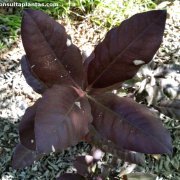Care of the shrub Acokanthera oblongifolia or Dune poison-bush |
|
The Acokanthera genus, family Apocynaceae, comprises 5 species of shrubs and trees native to Africa, Yemen and China. The species are: Acokanthera oblongifolia, Acokanthera oppositifolia, Acokanthera friesiorum, Acokanthera schimperi, Acokanthera ouabaio. Common names: Dune poison-bush, African wintersweet, Hottentot's poison, Poison arrow plant and Wintersweet. This species is native to South Africa and Mozambique. They are shrubs or small slow-growing evergreen trees that reach 6 meters (19.68 feet) in height and 3 meters (9.84 feet) in width. The leathery, fleshy leaves are bright green or burgundy in color. The flowers are white or pink and have a jasmine scent. They bloom in late winter. The toxic fruits are black when ripe. Dune poison-bush is used to form hedges, barriers and screens, as isolated specimens and in pots for patios and terraces. They are ideal for Mediterranean coastal gardens. Acokanthera oblongifolia grows in full sun and light shade exposures. Resists light and occasional frosts. The soil can be normal, well-drained garden soil with coarse sand and containing abundant organic matter. Water regularly, waiting for the substrate to dry; they resist drought well when they are settled. Young plants need more watering during the first 2 years after planting. Fertilize with manure or compost in autumn. Prune lightly after flowering to maintain a compact appearance. African wintersweet is a plant resistant to the usual pests and diseases. Poison arrow is propagated from seeds sown in spring or fall and by cuttings in summer. |
Images of the shrub Acokanthera oblongifolia or Dune poison-bush |
Find plants
Acokanthera oblongifolia or Dune poison-bush | Care and Growing
© 2025 FavThemes





